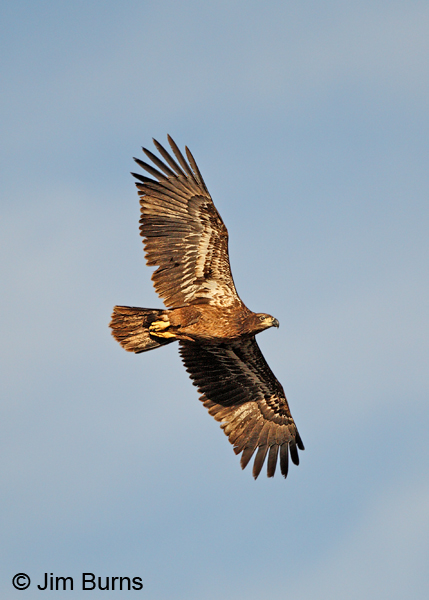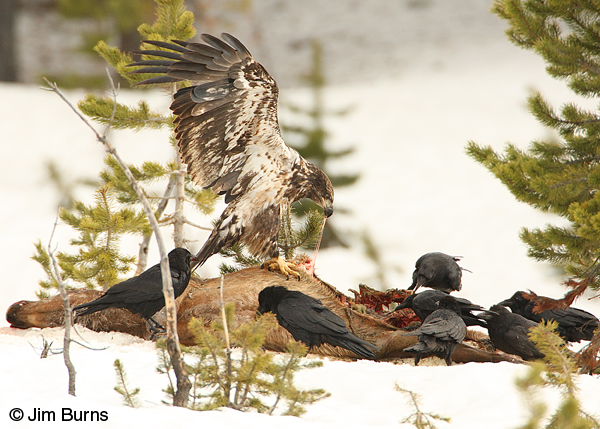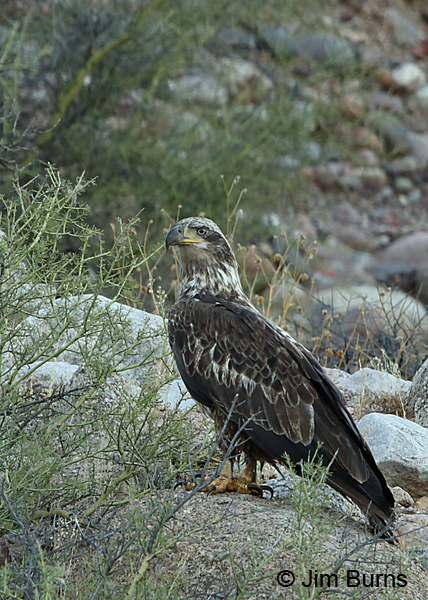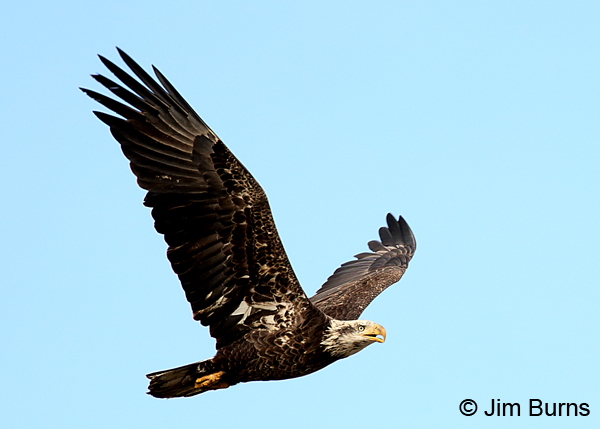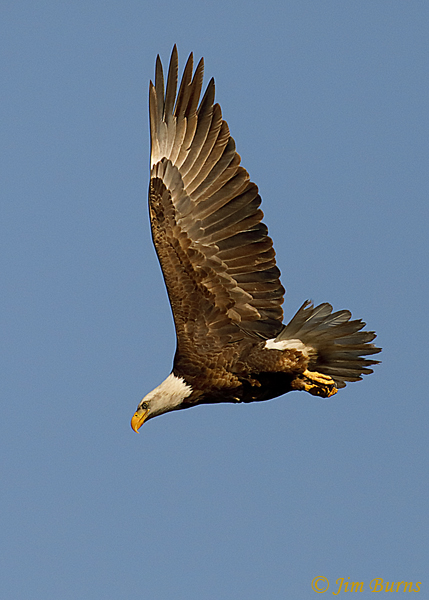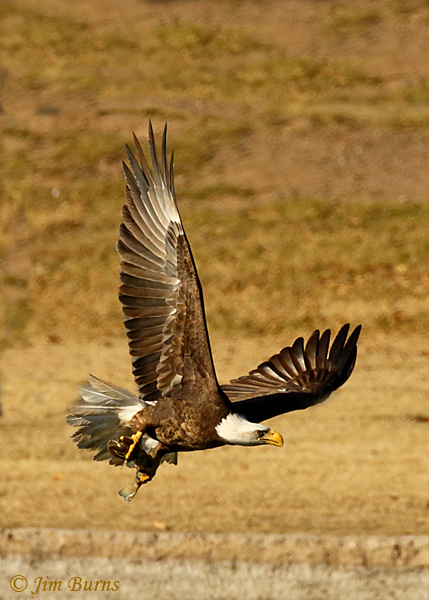Bald Eagle in symbolic adult plumage
One day last December I was standing at the edge of a local fishing lake, stocked periodically with trout and catfish, watching an Osprey circling overhead. And circling. And circling. I had never seen an Osprey circle for so long without making a plunge or leaving. Watching with me were two gentlemen I had only recently met, one an intermediate birder, the other a non-birding but avid photographer living in the neighborhood who comes out every morning to photograph two adult Bald Eagles frequenting the lake.
Suddenly the photographer shouted “Red-tail!” The birder and I diverted our gaze from the Osprey to see another raptor flying in, above and almost in line with the circling Osprey. How far above was it? Turns out it was way above, but we didn’t realize that at first. But I knew immediately, looking through my own camera with a telephoto lens, this second raptor was not a Red-tailed Hawk. Still it took me a moment to figure out what we were seeing because it appeared to be the same size as the Osprey.
This second bird was on a mission, never intersected with the Osprey’s circles or even paused, and two things contributed to our initial lack of collective recognition. The first was it seemed Osprey size because of the great height at which it went over. And secondly, neither the head nor the tail was white. Pumping up the image on the back of the camera, I saw an immature Bald Eagle. My companions were skeptical until I pointed out the huge bill and reminded them Bald Eagles don’t reach their visually iconic adult plumage until at least four years old, often five.
Bald Eagle is the second largest bird (after California Condor) in North America, and one of the most studied, photographed, and revered. Not many Americans would NOT recognize an adult Bald Eagle, but few would recognize a sub-adult. Plumage prior to full adulthood is highly variable and depends on the age of the bird and the timing and sequence of the molt. Birds of North America (BNA) states that “overall, the most consistent characters for determining age of Bald Eagles are color of head, bill, cere, and iris.” Nonetheless, I’m going to give plumage a go simply because my camera loves Bald Eagles and I cannot see one without shooting, especially those overhead.
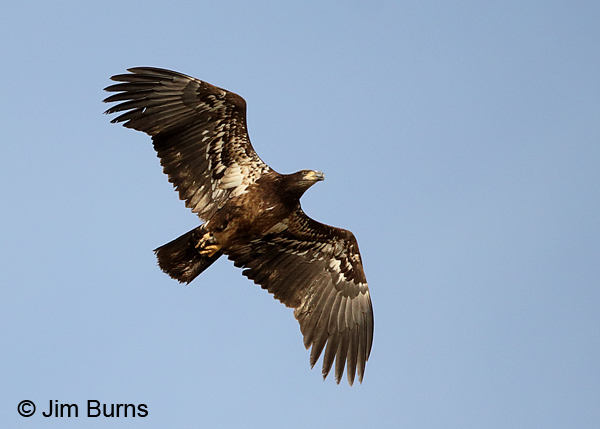
Bald Eagle juvenile
Bald Eagle juvenile
Juvenile Bald Eagle plumages show the least variability of any age. You can see this in the shots above of two different juveniles, head, body, wings, and tail blackish to dark brown in both, the only difference being that the second bird was shot closer to dawn and the lower sun angle has illuminated the plumage and made it appear lighter. In both photos we see the beak and cere are black to slaty gray and the iris is brown.
There is some white mottling in the wings, the “armpits” show extensive white, and the inner primaries show enough white that the wings appear to have narrow light panels or windows. It was helpful that these two birds were nearly directly overhead. Juveniles flying at a distance or seen in poor light will just look like huge, dark raptors, size alone perhaps being the only thing that might say “eagle.” Both these photographs were taken in early March, but several years apart.
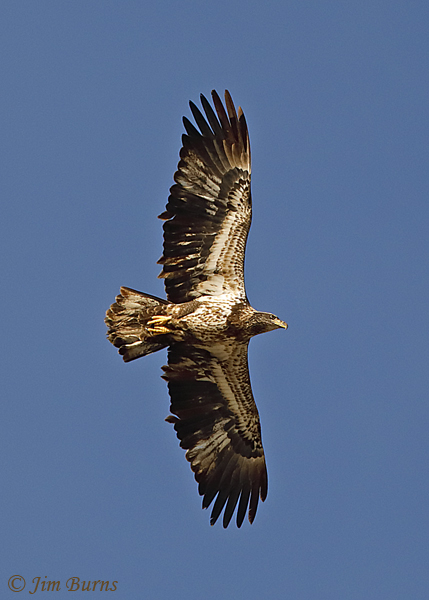
Bald Eagle immature (Basic I) with retained juvenile primaries showing as uneven trailing edge of wing
Bald Eagle immature (Basic I) on Elk carcass
Sub-adult I (also called Basic I) Bald Eagles are anywhere from one to two years old and have molted out of their juvenile plumage. The first photo is the flyover eagle at the fishing lake last December which stimulated my research for this article. It shows considerably more white on the belly and a bit more on the tail compared to the juveniles, but the most interesting aspect of this bird is the markedly uneven trailing edge of the wings.
These wing margins appear ragged because the bird is young enough it still retains several (looks like six, to be exact) juvenile flight feathers, three in the same place on each wing, and the inner primaries still appear as a light panel running the width of the flight feathers. This “window” was the first visual clue I had that the bird was not a Red-tail.
The eagle in the second photo, taken one year in Yellowstone National Park in late May, is also a sub-adult I bird, but is apparently older because the belly is predominantly bright white, and the finished molt is evident in the even trailing margin on the wing we can see. The beak and cere are still black, the iris still brown. The photo is interesting, of course, because it clearly shows that the huge beak, evolved to rip through fish scales, is good for carrion as well and that its owner is an opportunistic feeder.
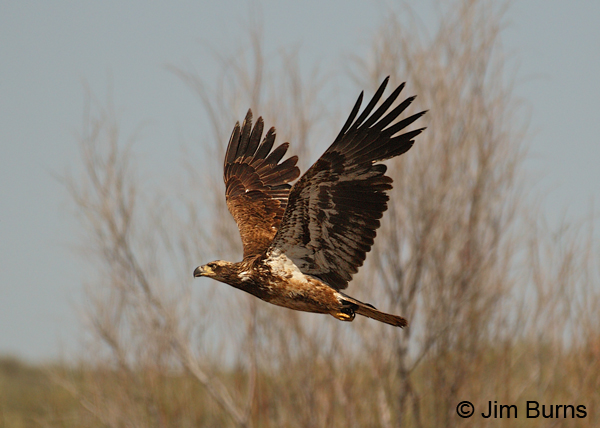
Bald Eagle immature (Basic II)
Sub-adult II (Basic II) Bald Eagles are anywhere from two to three years old. The photograph of this one was taken in late March and clearly shows three features distinguishing it as older than the Basic I birds: the iris is creamy white, not brown; the top of the head is lightening considerably, though certainly not yet white; the same is true of the throat, belly, and tail though the shadowed view of the ventral surface in this photo makes this hard to see.
The axillaries (armpits) and underwing coverts of this bird still exhibit a lot of white and the light window the length of the primaries is visible, but it appears the inner primaries are undergoing a molt. The bill is still dark, but the cere looks to be lightening toward yellow.
Bald Eagle immature (Basic III)
The eagle in the next photo is a sub-adult III (Basic III) bird, the photo taken in early May. This stage is sometimes referred to as “transition,” and transition birds are three and four year olds. The body is almost all dark, the head and nape at least partially white, and the cere and iris lighter than those in the previous bird, though the bill here is still dark.
The tail of Basic III Bald Eagles is mostly light with a darker tip, although the tail is not visible in this shot. The belly is entirely dark, but there is light speckling on the throat and upper back which are visible here. Because of their dark bellies and white axillaries, Basic III birds can resemble juveniles of the same species.
Bald Eagle immature (Basic IV-Transition)
Sub-adult IV (Basic IV) Bald Eagles are four and five year olds in their first adult plumage. Some, like the one pictured here, will still show white in the armpits and dark head feathers manifesting as a posterior eyeline on an otherwise white head. You can see on this bird that the iris and cere are bright yellow, though the bill still has dark patches, and there is dark splotching on the throat.
This photo was taken in December, and eagles in this plumage are often mistaken for Osprey because of the dark eyeline and the fact that both species hang out around rivers and lakes searching for fish. Some four-year-old Bald Eagles may have fully developed white heads and tails, again a caveat against trying to assign a definite age to all the sub-adult eagles you see.
Bald Eagle adult (Bandit) diving
Bald Eagle adult (Bandit) with trout
Adult Bald Eagle plumage needs no description or explanation. Huge dark bird, white at both ends, succinctly sums it up for birders and non-birders alike. Four to five year old adults are unmistakable, but it’s interesting to put an asterisk on the birds in these last two images, the same bird photographed on two different occasions, once in a dive and again pulling a trout out of the urban lake mentioned at the beginning of the article.
Eagles are monogamous and mate for life. This eagle, a male, is known by Arizona Game and Fish to have sired at least four chicks in two different breeding seasons, and he’s back again this year with a different female, apparently his original partner having met her demise. The neighbors around the lake have given the frequently observed and well known male a name, “Bandit,” because of the very discernible dark shading evident behind its eye. Bandit’s new mate is white as the driven snow, both fore and aft, and she is a tagged bird.
Despite the somewhat dark post ocular eyeline, which has fooled some into thinking Bandit is “just” an Osprey, there is no reason to believe he isn’t a fully adult Bald Eagle, primarily because he has nested and produced offspring for at least three seasons now. My hope is that, because the nest is on a nearby golf course, the juveniles from this year’s hatch will hang around for awhile, enlightening the neighborhood non-birders, most of whom are well aware of Bandit and the doorway to urban wildlife which he provides.
The purpose of this article has not been to offer a definitive guide to aging immature Bald Eagles, but rather to remind birders and alert non-birding nature lovers that young Bald Eagles come in a fascinating variety of plumages which can make them more fun and interesting to observe than the rather common and very familiar majestic symbol of our country. Enjoy.
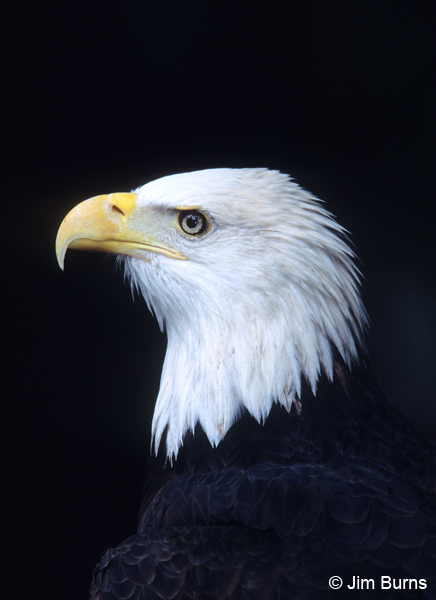
The classic adult Bald Eagle, an American icon


